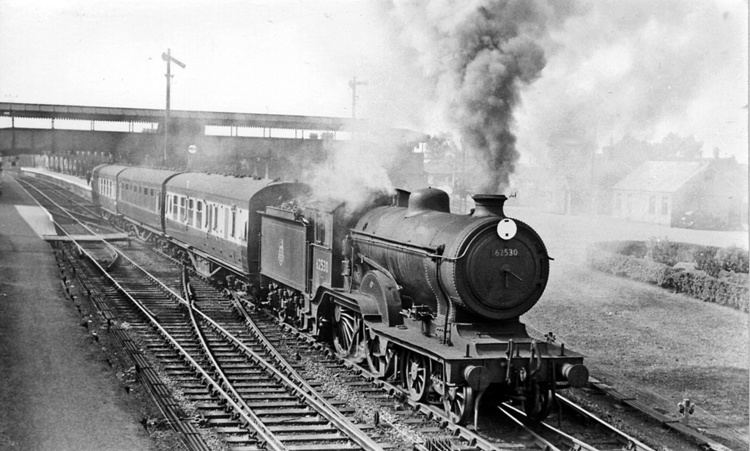Power type Steam Build date 1900-1923 | Total produced 121 UIC class 2′B n2, 2′B h2 | |
 | ||
The GER Classes S46, D56 and H88 (classified Classes D14, D15, and D16 by the London and North Eastern Railway) were three classes of similar 4-4-0 steam locomotive designed by James Holden (S46 and D56) and A. J. Hill (H88) for the Great Eastern Railway. They were given the nickname Claud Hamilton after the first engine of the class, named after Lord Claud Hamilton (1843–1925) the chairman of the Great Eastern Railway. None of these locomotives survived to preservation.
Contents
History
Allen (1961) noted that
"Of all the locomotive designs that emerged from Stratford Works during the reign of James Holden, the one destined to achieve the greatest fame, beyond question, was his Claud Hamilton type 4-4-0, of which the pioneer example, No. 1900 Claud Hamilton, took the rails in 1900"
He devotes a whole chapter to it. It is widely considered one of the classic locomotive designs, and three later Great Eastern Railway classes and three LNER classes were descended from it. F.V. Russell (Holden's Chief Designer) is generally accepted as the Claud Hamiltons' actual designer. Ellis notes:
"Mr Holden, by then a valetudinarian was making a long recuperative stay in Egypt".
This was related to Ellis by Russell.
Classification
The classification of the Claud Hamiltons is complex but is summarised here:
Dimensions
The S46 boiler had 1,630 sq ft (151 m2) of heating surface, with a 21.3 sq ft (1.98 m2) grate. The cylinders were 19 x 26 in. with flat valves placed below, operated by Stephenson's motion. The coupled wheels were 7 ft (2.1 m) in diameter.
Performance
(Allen 1961) reports Claud Hamiltons in their original state were capable of taking around 350 tons from Liverpool Street to North Walsham in under the booked time. No. 1882 with round-top boiler ran the 130.2 miles (209.5 km) in 156 min 60 sec. Even heavier trains were managed in the up direction: No. 1809 (Belpaire boiler) took 400 tons up in 157 min 24 sec.
Appearance
The royal blue of the Great Eastern livery, with its scarlet lining, was embellished with a copper chimney cap, and brass beadings round the rim of the safety valve casing, the front and side cab windows, the top and bottom of both cylinders of the Westinghouse brake compressor, the coupled wheel splashers, and the four openings that had been cut in subsidiary coupling rod splashers – in London and North Western Railway style – to give access to the coupling rod pins when the rods were up. In contrast with the blue livery was the vermilion in which the buffer beam and coupling rods were painted. Another feature of great distinction, begun by James Holden with the Claud Hamiltons, was the broad steel ring, polished bright, that encircled the smokebox door, and made it possible to dispense with the usual straps across the door. Before very long, the painted representation of the GER coat-of-arms on the driving splashers was replaced by a replica cast in relief and picked out in colour. The tenders were replaced with standard GER ones when oil firing came to an end. The cab windows were round.
Later in LNER days the locos were painted apple green with LNER on the tender and cab-side numbers. Side rods were polished steel. The appearance was altered when a larger boiler and Belpaire firebox was fitted, meaning a change in the cab window shape as well. 8783 and 8787 were kept in immaculate condition as dedicated Royal locos for hauling the Royal train from King's Cross to Wolferton (for Sandringham). 8783 was also fitted with a copper-capped chimney. Later some locos carried numbers and London & North Eastern Railway on the tender. During the Second World War most were repainted into unlined black livery with the letters "N E" on the tender.
"Royal Claud" 8783 retained its LNER apple green livery into British Railways days (after 1948), but with BRITISH RAILWAYS on the tender initially. Others were painted black with BRITISH RAILWAYS on the tender. Later on they carried both lined and unlined black with the early BR crest and those which survived after 1956 lined and unlined black with the later crest. Many of the class retained steel smokebox door rings until withdrawal, except those rebuilt by Gresley with a larger boiler which also required a new smokebox. Many locos had their decorative valancing removed in later years as well, though they still retained their distinctive character.
In fiction
The design was the basis of the character Molly in the children's TV series Thomas the Tank Engine and Friends. 8783 also featured as a character in Toby and the Old Engine story.
Preservation
There are no survivors of the original class, however there is a group who have planned to build a replica Claud Hamilton D16/2 No. 8783 as it was one of the original engines which pulled the royal train, this engine will be named Phoenix.
